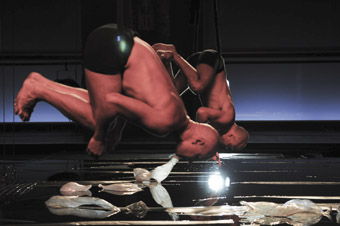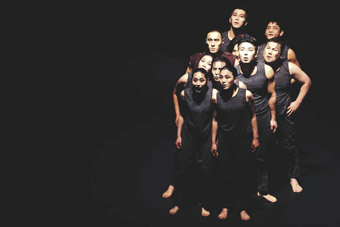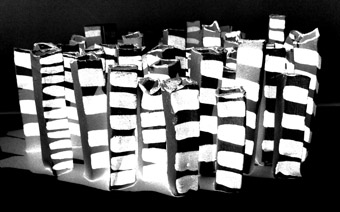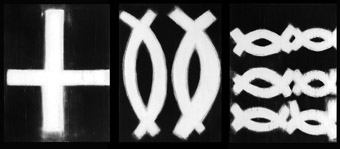in the loop
realtime news and advance word
version 1.0: this kind of ruckus
At an Induce workshop at the On Edge Festival in Cairns in July, David Williams of the performance group version 1.0 was adamant that the company does not make verbatim theatre. Rather, he says, it immerses itself in the epic official documents and media material pertaining to political crises (‘children overboard’, ‘wheat for weapons’) which it then distils, quotes from and transforms into surprising, often quite lateral, sometimes satirical images that encourage us to look twice at the contradictions and corruption too easily veiled by spin and the welter of the everyday.
After the extensive regional tour of their ‘wheat for weapons’ show, Deeply offensive and utterly untrue, the company has plunged into the creation of a new work “about gender, power, control and violence”, titled This kind of ruckus. The show investigates “the underside of domestic bliss…with commentary on the recent high profile sexual assault scandals involving Rugby League players.” The show will “reflect on violence within ourselves and our own relationships.” Williams says it’s not about Rugby League: players, officials, politicians, will not be named—a first for a version 1.0 show. The aim is “to open up a fissure in the culture with the possibility for public discussion, and then ask ‘How should we behave?’ The world permeates version 1.0 performances”, Williams adds.
The recent string of sports-related sexual assaults, inconsistent policing of domestic violence and “the horrible logic of public opinion” that believes a woman entering a pub for a drink has herself to blame if she’s raped, suggest for version 1.0 the many grey areas that remain in gender relations in public but also in private life. The company have researched couple therapy and looked at their own behaviour through improvisation, including for Williams, assessing his own relationship with female performers, how he moves, gestures and “when it’s not about me.” The collaborating artists are Danielle Antaki, Sean Bacon, Kim Vercoe, Paul Dwyer, Jane Phegan, Deborah Pollard, Gail Priest, Arky Michael, Christopher Ryan, Yana Taylor, David Williams, Neil Simpson. version 1.0, This kind of ruckus, Sept 4-12, Performance Space at CarriageWorks, Sydney, www.versiononepointzero.com; www.performancespace.com.au

Dean Walsh, David Clarkson, MirrorMirror, Stalker, Parramatta Riverside Theatres
photo Heidrun Löhr
Dean Walsh, David Clarkson, MirrorMirror, Stalker, Parramatta Riverside Theatres
stalker: mirrormirror
Physical theatre company Stalker’s MIRRORMIRROR brings together artistic director David Clarkson and dancer-choreographer Dean Walsh with “their ghostly puppet counterparts” enacting life “from beginning to end—from the ground to the air—evok(ing) images of the spirits of our ancestors…” The pair share Irish Celtic and working class backgrounds. This exploration of “personal endings” is the third work in a Clarkson triptych: the first was Four Riders, drawing on the Book of Revelations; the second was Red, about scientific visions of the end of the world. Collaborators include set designer Joey Ruigrok, lighting designer Sydney Bouhaniche, puppet fabricator/sculptor Kassandra Boswell, composer Peter Kennard; Riverside Theatres, Parramatta, Oct 2-10; riversideparramatta.com.au.

Woyzeck, Sadari Movement Laboratory, OzAsia Festival
photo Eun Sun
Woyzeck, Sadari Movement Laboratory, OzAsia Festival
2009 ozasia festival
The first announced events of the 2009 OzAsia Festival program are complementary, cross-cultural collaborations of a high order. Akram Khan will present bahok, originally a collaboration with the National Ballet of China, now performed by eight dancers—Chinese, Slovakian, Korean, Indian, South African and Spanish—with music by Nitin Sawhney. Into the Fire is a musical concert with dance: Paul Grabowsky and the Australian Art Orchestra will collaborate with South Indian Mridangam player Guru Kaaraikkudi Mani, members of the Sruthi Laya percussion ensemble and Bharatanatyam dancer Rajeskwari Sainat. Earlier versions of Into the Fire in concert and on CD have displayed a rivetting synthesis of traditional Indian music and adventurous western jazz with each maintaining their integrity. Khan’s bahok “aims to create a modern day utopian community. The performers meet in one of this globalised world’s transit zones and try to communicate, to share ‘the things they dream with’—their experiences, their memories of their original homes, the dreams and aspirations that made them move. They are carriers. They are bahok.”
Providing a welcome contemporary performance perspective are Melbourne-based dancer Yumi Umiumare in her new solo work, En Trance, and, from Korea, the only Australian season of the Sadari Movement Laboratory’s physical theatre interpretation of Buchner’s Woyzeck, performed with a set of dextrously deployed chairs—swung, danced, piled high—to the music of Astor Piazolla. OzAsia continues to be a rarity in Australia—a celebration of our relationship with our nearest neighbours and a sad reminder of the paucity of Asian programming in our major arts festivals. OzAsia Festival, Adelaide Festival Centre, Oct 3-17, www.adelaidefestivalcentre.com.au/ozasia
seam 2009: spatial phrases
The inaugural SEAM conference and workshops bring together architecture, film and dance to explore “ideas of movement across bodies and space.” Hosted by Critical Path and the University of Technology Sydney’s Centre for Contemporary Design Practice, the program includes a three-day Symposium with international speakers including architectural and cultural theorists Erin Manning, Brian Massumi, Andrew Benjamin and Pia Ednie-Brown. Commissioned installation projects and performances from local artists will be showcased and interdisciplinary workshops held at Critical Path. International artist talks will include choreographer UK-based Carol Brown, Marten Spangberg from Germany, UTS Design Head of School, Professor Lawrence Wallen and Dr Benedict Anderson, Course Director of Spatial Design at the University of Hertfordshire.
Works include Brisbane-based Jondi Keane and James Cunningham’s performance installation Tuning Fork (RT89, p32) and Sue Healey’s installation The Door, The Chair, The Bed and the Stair with architect Mark Healey, digital artist Adam Synnott and performer Nalina Wait. With four large screens, “the images [will] play with our perception of space, amplifying an emotional and physical response to specific architectural framing.” A video animation, Falling, by Nikki Heywood and Heidrun Lohr [see p20], comprises some 3.400 photographs and is based on the?experience of Heywood’s mother, who had several falls in her apartment. The artists write that “this gives us the possibility to explore, from a different and curious angle, the passing of time and the dynamics of a body literally collapsing inside and against an architectural space.” Richard James Allen and Karen Pearlman’s presentation, “Entanglement Theory”, will hypothesize “that a mash-up of Vedic spiritual philosophical ideas of multiple states of consciousness, multiple forms of body and multi-dimensional realities and the elemental beings that inhabit them, along with science fiction-like theories of quantum particle entanglement” can be explored through a mix of RealLife and Second Life. Critical Path director Margie Medlin’s Miss World installation (2002) also mixes the real and the virtual to “create new choreographies” using “the dancer’s movements to draw attention to the body in the changing face of cities and the culture of urban planning.” SEAM09: spatial phrases; Sydney, various venues, Sept 7-20, www.criticalpath.org.au/SEAM.html

Triptych Primordial Landscape, painting by Jenny Mullet, Tandeera
courtesy the artist
Triptych Primordial Landscape, painting by Jenny Mullet, Tandeera
tandeera: indigenous projects
Three Gunnai/Kurnai artists from eastern Victoria have been working with leading Australian projection artist Ian de Gruchy to create the first indoor Koorie art projection exhibition, Tandeera (“place of rest”), in Melbourne. In a press release, de Gruchy explains that the installation “required the use of pre-digital technologies using orthographic film and programmed slide projectors to translate the artists’ work onto the black painted walls of the gallery.” The works meditate on “the themes of resting and healing post-apology…to soothe the soul.” Koorie Heritage Trust, 295 King St Melbourne to Aug 21.

Landscape of Birds by Jenny Mullet from ceramic installation, Tandeera
courtesy the artist
Landscape of Birds by Jenny Mullet from ceramic installation, Tandeera
billy twinkle—requiem for a golden boy
Virtuosic Canadian puppeteer Ronnie Burkett returns to Australia, playing Melbourne’s Arts Centre (Aug 25-29), Geelong Performing Arts Centre (Sept 3-20) and Sydney Opera House (Oct 1-17). Meg Walker saw Burkett’s new show in Vancouver and wrote, “Compared with (his) last two works the tender and restrained Ten Days on Earth and the brutal, brooding Provenance the puppeteer and writer’s latest work is full of bustle and glitz. The plot demands it: Billy is a cruise ship entertainer who has just been fired for insulting passengers during his cabaret act puppet shows. Vain, middle-aged and full of self-loathing, the man in the dinner jacket needs a reason to carry on” (RT90, p5).
look out for…
For films with a difference, try the Melbourne Underground Film Festival (MUFF), August 22-30 or the Sydney Underground Film Festival, Sept 10-13. Sydney performance trio, post, will mount their wickedly funny and bizarrely intelligent new show, Shamelessly Glitzy Work, at Melbourne’s Arts House, August 13-15. Also at the Meat Market is live art duo Panther’s Playground, a New World Order where the audience get to be kids again if in some dark scenarios. Aptly for our self-conscious times, Adelaide’s Brink Theatre premieres The Hypochondriac (adapted from Moliere’s Le Malade imaginaire) August 5-22 at the Space Theatre. Under the banner Come Hither Noise, Fremantle Arts Centre is exhibiting works by artists from around Australia: Mark Brown, John Conomos, Richard Crow, Ross Manning,Thomas Meadowcraft, Elvis Richardson, Sam Smith and Sriwhana Spong; August 1-September 20.
RealTime issue #92 Aug-Sept 2009 pg. 55






